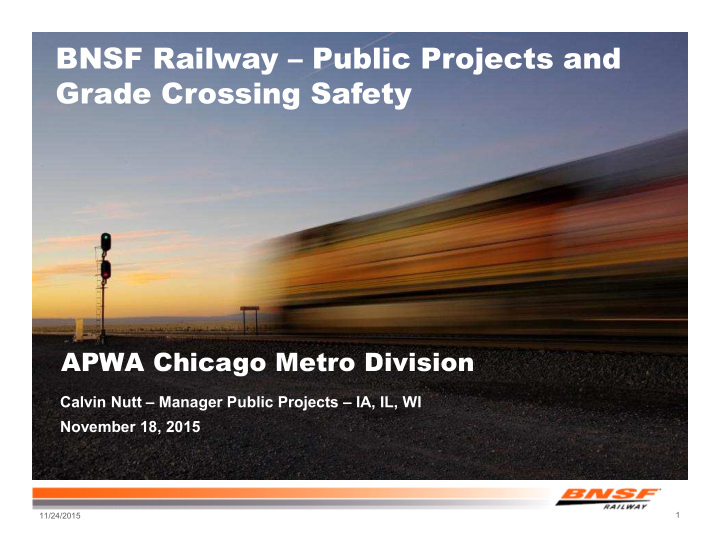



BNSF Railway – Public Projects and Grade Crossing Safety APWA Chicago Metro Division Calvin Nutt – Manager Public Projects – IA, IL, WI November 18, 2015 1 11/24/2015
Agenda - BNSF Public Projects Overview - Crossing Safety - At-Grade Crossing Consolidation - Interconnection/Preemption - Pedestrian Concerns - Grade Separations - Permitting - Public Projects Department vs. Jones Lang LaSalle - Contractor Safety 2 11/24/2015
BNSF Overview - 32,500 miles of track - 28 States, 3 Canadian Provinces - 47,000 Employees - Average 1,600 trains/day - 10 million carloads in 2014 - 50 million packages each holiday season - 500 miles/gallon for 1 ton of freight - 8,000 locomotives - 13,000 bridges - 25,700 Grade Crossings 3 11/24/2015
BNSF Public Projects Team Public Crossing Statistics - Chicago Area - 105 At-Grade - 31 Overpasses - 84 Underpasses - Illinois - 1,500 At-Grade - 168 Overpasses - 206 Underpasses 2015 Projects Total = $88MM 4 11/24/2015
Public Projects Overview Project Types - Roadway Realignments/Widening - Grade Separations - Signal Installations - Surface Installations - Grade Crossing Closures - Improvement projects paralleling BNSF ROW - Quiet Zones - Multi-use paths 5 11/24/2015
Public Projects Overview - Responsibilities - Project Administration - Conceptual or Preliminary Plan Approval - Internal BNSF Coordination on Agency Projects - Facilitating plan review - Project meetings - Project scheduling - Agreement Negotiations - Contractor Onboarding - Preconstruction Meeting - Project Hand-Off 6 11/24/2015
Grade Crossing Safety Highway-railroad grade crossing safety is an integral part of BNSF’s operation and culture and involves the daily cooperative effort of many employees 7 11/24/2015
Grade Crossing Safety Crossing Facts - It takes a fully loaded freight train moving 50 mph approximately 1 ½ miles to come to a complete stop - Motorists are 40 times more likely to die in a crash with a train than with a motor vehicle - Trains can’t swerve – travel on set route - Large objects appear to be traveling slower than reality - Any time is train time - Varied levels of warning devices - Most train/vehicle crashes are preventable Crossing Statistics - 52% of BNSF crossing collisions occur at active-warning crossings 8 11/24/2015
Grade Crossing Safety Nearly all grade crossing collisions are caused by motorist error Stopped, Proceeded 71 4% Did Not Stop Stopped on Tracks: 482 (29%) 593 (36%) Other 228 Drove Around (14%) Gate: 212 (13%) Sources: AAR Analysis of Highway-Rail Incident Database for 2013 (March 2014). FRA, Railroad Safety Statistics Annual Report 2010, Table 8-6. Note: Motor vehicle highway-rail incidents at public crossings. 9 11/24/2015
Grade Crossing Safety Warning Classes - Passive (Cross Bucks, Yield Signs, Stop Signs) - Active (Traffic Signals, Flashing Lights, Lights and Gates, Four-Quadrant Gates) 10 11/24/2015
Grade Crossing Safety Crossing Consolidation - The safest at-grade crossing is ALWAYS no at-grade crossing - BNSF Program to reduce at-grade crossings - Started in 2000 - Currently 30-35 team members - Built on Education, Engineering, and Enforcement - Successfully eliminated 6,000 crossings - Any at-grade crossing is a potential closure, and any closure is beneficial 11 11/24/2015
Grade Crossing Safety Crossing Interconnect/Preemption - BNSF supports installation of new preemption as well as improvements to existing preemption - Road authority determines required preemption time and requests from BNSF 12 11/24/2015
Grade Crossing Safety Quiet Zones - FRA Train Horn Rule establishes requirements for use of horn when approaching at-grade crossings - Public authorities may establish Quiet Zones in accordance with FRA rule (Pt. 222 of 49 CFR) - Public Authority is the owner of the process - BNSF is involved in the process and encourages SSM’s at every crossing to create a sealed corridor - SSM’s include four-quadrant gates, closure, and medians 13 11/24/2015
Grade Crossing Safety Pedestrian Treatments - New Chapter 8D approved for next publication of MUTCD - Will be used for future roadway reconstruction, streetscape, and commuter platform projects 14 11/24/2015
Grade Separations - Railroads can be obligated to contribute 5% to initial grade separations. - Additional funding potential if multiple at-grade crossings are eliminated - 5% number does not include aesthetic components, additional landscaping, etc. - All grade separations must meet the requirements of the BNSF/UP Grade Separation Guidelines - Highway structure typically more feasible than railway structure - Lower loads - Shorter span - Higher maximum allowable grade 15 11/24/2015
Municipality Project Coordination BNSF is involved in - Design - Permitting - Right-of-Way - Contract Negotiation - Contractor Safety - Construction Inspection/Coordination 16 11/24/2015
Permitting with BNSF Temporary Occupancy and Utility Permits - Pipelines, utilities, surveys, geotech, etc. - Handled by Jones Lang LaSalle (JLL) - 6-8 weeks to obtain - $750 processing fee (approx.) - $2,500 permit fee (approx.) - Permit outlines insurance, flagging, safety, etc. - Information at www.bnsf.com/communities/faqs/permits- real-estate/ 17 11/24/2015
Public Projects vs. JLL When do you use BNSF Public Projects vs. JLL? - Public Projects - Grade separations, roadway widening, new crossings, crossing reconfiguration/reconstruction, quiet zones, closures, etc. - JLL - Surveys, geotech, utilities, permits, maintenance ROE 18 11/24/2015
Contractor Safety Flagging Requirements - Work within 25 feet of track centerline - Work on BNSF ROW - Work is capable of fouling track - Within 4’ of track if equipment falls (cranes and excavators) - Coordinated through local Roadmaster - Paid by road authority - Required through ROE, permit, or C/C1 Agreement 19 11/24/2015
Contractor Start-Up - Right of Entry - Minimum 30 days for ROE, permit, or C/C1 Agreement - Contractor Orientation - BNSFContractor.com - Covers safety requirements when working on BNSF ROW - Must have card and photo on person when on BNSF ROW - E-RailSafe - www.e-railsafe.com - Personnel screening and security management - Submittals (overpass/underpass projects) - Contractor submittal requirements included in Grade Separation Guidelines - Submittals require 4 weeks for each review cycle - Consider consultants and contractors with railroad expertise. 20 11/24/2015
Questions? Calvin Nutt Manager Public Projects Minneapolis, MN Calvin.Nutt@BNSF.com 21 11/24/2015
Recommend
More recommend